




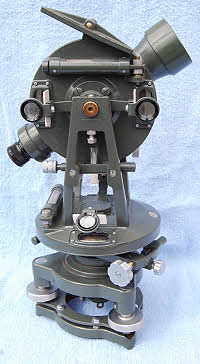
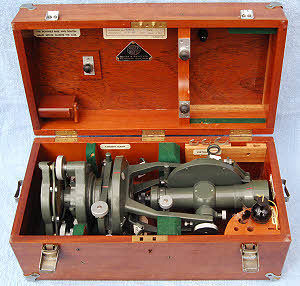
Hilger & Watts vernier theodolite type ST2, serial number 190802 dating. I think, from 1966. The fitted mahogany box still contains the plummet, brush, three spanners, and a spare diaphragm. The olive green enamel is unmarked but there is some tarnishing of the silver scales and verniers, and two of the white plastic reflectors for throwing light onto the verniers were broken, which I have since replaced. The upper horizontal plate motion is too stiff but otherwise it appears to be in excellent working order.
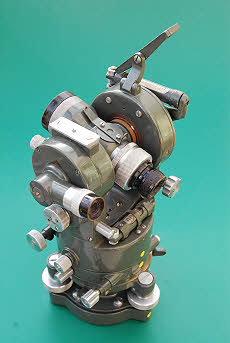
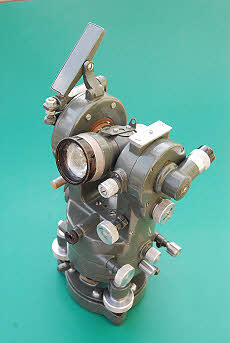
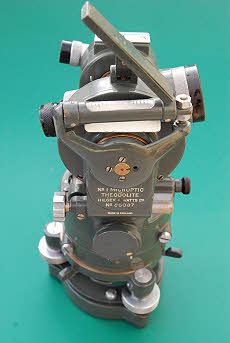
Hilger & Watts No 1 Microptic theodolite serial no 86087, probably dating from 1954. It is complete with fitted steel case and stand and has a plummet in the case and a ray shade. The elevation and azimuth circles are glass and finely engraved. The verniers for both are viewed through the eyepiece on the left hand side of the instrument and are illuminated by a mirror that folds out just below the signature. An accessory that I do not have was a battery powered lamp that could be fitted in place of the mirror to illuminate the optical path. The instrument is in good working order. The stand can also be used with my Hilger & Watts vernier theodolite shown above. The Microptic has the same 20 second resolution as that instrument but is more compact

Eleven inch drainage level, ca. 1790-1820. It is unsigned and it appears that a trade label has at some time been lost from inside the lid - possibly when it was some time later for sale second-hand for £3.10s. The case is mahogany and has hand dovetail joints. The No. 163 in the lid may well be the original maker's number.
The two screws in the lower limb were probably for the attachment of a compass. It has a rather unsightly solder repair where the original fixing screw{s} has been lost or the thread damaged that I shall try and clean up in due course.
However the level tube is still intact, the eyepiece and objective are in good condition and focus correctly and the cross hairs are still in position although the horizontal one is displaced at one end. The link hinges are a little sloppy
from 200 years wear.
The two screws in the lower limb were probably for the attachment of a compass. It has a rather unsightly solder repair where the original fixing screw{s} has been lost or the thread damaged that I shall try and clean up in due course.
However the level tube is still intact, the eyepiece and objective are in good condition and focus correctly and the cross hairs are still in position although the horizontal one is displaced at one end. The link hinges are a little sloppy
from 200 years wear.


Gardner & Co drainage level, serial no 197 (on the reverse of the scale arm). Signed Gardner & Co, 21 Buchanan St., Glasgow Registered No 2602 December 28th 1850. This instrument dates from ca.1859. The firm moved to 53 Buchanan St the following year. The telescope is focused by withdrawing the eyepiece.

Gravatt pattern (dumpy) level by William Elliott, 268 High Holborn London dating
from 1835-
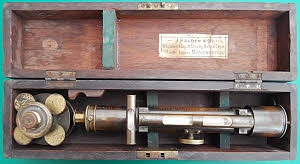
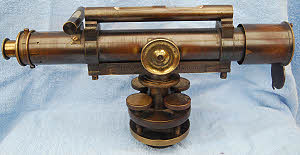
12” dumpy level signed J B Dancer Optician Manchester. John Benjamin Dancer (1812-1887) was working from 1835 until 1878 and it is likely that this level dates from near the end of that period. It has a trade label for J Halden in the lid of the box who may just possibly have sold it new but more likely sold it secondhand or repaired it at some point as Joseph Halden did not start a business on his own account until 1880 after a short (1878-1880) partnership with Alexander George Thornton. The level is mainly oxidised brass or bronze and is in good working order. Typical of levels of this period the parallel plates with their four levelling screws can be detached from the rest of the instrument. The telescope has rack & pinion focusing and an extendable ray shade.
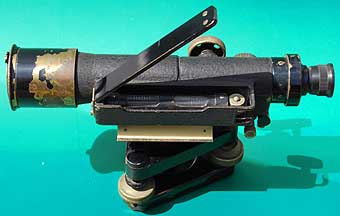
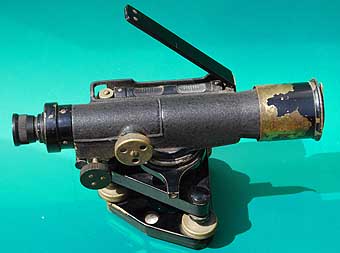
E R Watts & Son Standard 10” dumpy level No. 20163 dating from ca.1941, agents J Halden & Co, Manchester & London. The level is mounted on a tribrach, in the base of which is a small circular spirit level for rough adjustment. The main (very sensitive) level is sighted through the mirror and there is also a cross level. The telescope is of the internal focusing type, the eyepiece separately focusing on the diaphragm. There is a clamp and slow motion (the clamp screw knob had sheared off and I have repaired it since the photos were taken). It has a fitted mahogany case.
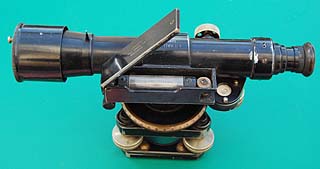
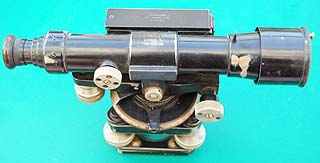
A H Hall & Bros 10” precision tilting level no 53649 supplied by Hall Harding & Co, Westminster, London. The level is mounted on a tribrach above which there is an azimuth scale. It is fitted with a clamp and slow motion although the clamp screw was missing and a replacement has now been made. One turn of micrometer screw for tilting the level is equivalent to a 1/100 slope and the barrel is graduated to 1/5000. The telescope is of the internal focusing type, the eyepiece separately focusing on the diaphragm. There is a circular bubble level for setting up as well as the sensitive level that is sighted through the mirror. Using the tilting function to take two readings on the stave, the distance can be calculated.
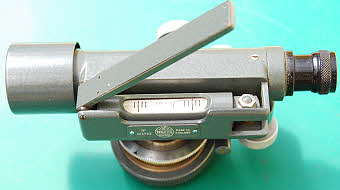
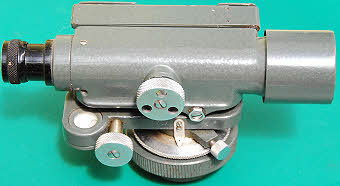
E R Watts & Son Quickset Level serial no 103762. It has a graduated azimuth circle and extending ray shade. It has a fitted leather case with the retailers plaque for Lawes Rabjohns and a 1959 dated repair/adjustment label inside for J Halden & Co. It is missing the quickset base part, presumably left screwed to the stand. It dates from about 1957 and by that time the firm was actually Hilger & Watts.
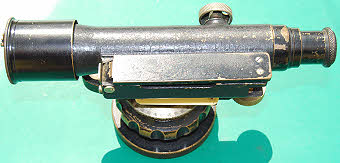
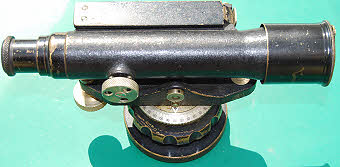
E R Watts & Son 8” Quickset level serial no 9335 dating from about 1924. J Halden & Co Agents is also stamped into the support for the telescope. It has a fitted leather case and instruction leaflet. Whilst the much later one above is internal screw focusing, this has the older form of rack and pinion focusing. The eye piece is rotated to focus on the cross hairs (that are missing from this level).
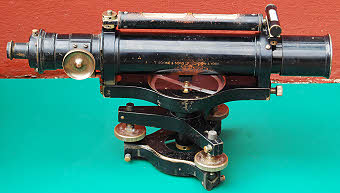
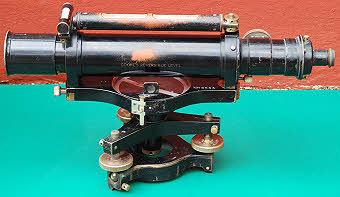
Cooke’s Reversible Level (signed on one side of the outer tube), signed on the other side T Cooke & Sons Ld London & York. It has a fitted wood case and dates from the early 20th century. W F Stanley describes it in his book on surveying instruments. By removing the thumb screw just under the telescope at the eye end and removing the ray shade, the telescope can be withdrawn from the outer tube and inserted from the other end. It can also be rotated about its own axis. It is intended to be used in the same way as a wye level. It also ha a prismatic surveying compass built into the telescope support. The telescope sight line can be adjusted by a pair of capstan nuts and a similar arrangement is used to bring the bubble level into collimation with the telescope. Although clearly much used it is still in good working order. 15” telescope. Serial No 15553.
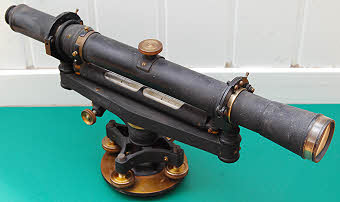
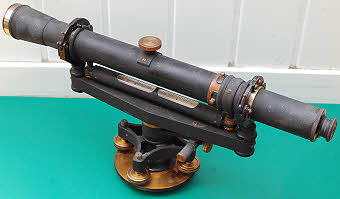
This 18” ‘Y’ level is stamped on the top of main limb on one side “Made by Y & S Dept Keuffel & Esser New York” and on the other “Young & Sons trade mark 74619” made in 1941. Missing ray shade, box and other accessories.
Young & Sons of Philadelphia, PA was a long established (over 100 years) company manufacturing surveying instruments, incorporated by Alfred C Young March 17th 1917. He died in May 1918 and the firm was purchased by K&E. Young & Sons Inc was dissolved Dec 20 1921 and in 1922 K&E moved the business to Hoboken, NJ. A special Y&S department was set up to manufacture simple, but substantial and accurate, instruments for sale at a lower price than their best range. A few instruments in this range were still being sold by K&E in the 1940s. This instrument has internal focusing.
Young & Sons of Philadelphia, PA was a long established (over 100 years) company manufacturing surveying instruments, incorporated by Alfred C Young March 17th 1917. He died in May 1918 and the firm was purchased by K&E. Young & Sons Inc was dissolved Dec 20 1921 and in 1922 K&E moved the business to Hoboken, NJ. A special Y&S department was set up to manufacture simple, but substantial and accurate, instruments for sale at a lower price than their best range. A few instruments in this range were still being sold by K&E in the 1940s. This instrument has internal focusing.
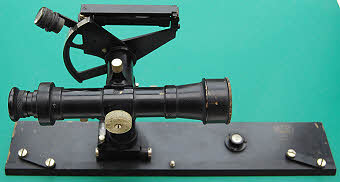
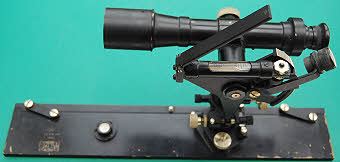
Telescopic alidade made in 1941 by Hall Bros, Purley Way, Croydon, England, serial number 41633. The instrument is marked with the Briitish Government “crow’s foot” and was probably supplied to the army. It would have been used on a plane table for mapping and could also be used for determining heights of features and determining distances as the eyepiece has stadia. It has a fitted wood case. The telescope is internal focusing. There are a clamp and slow motion for fine vertical adjustment, a magnifier for reading the vernier, and a screw for cross levelling. It is combined with a parallel rule for plotting the sight line.
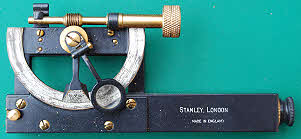
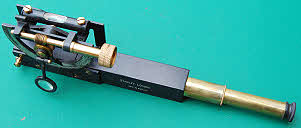
Abney level made by W F Stanley, in the 2nd quarter of the 20th century. It has a leather sling case.
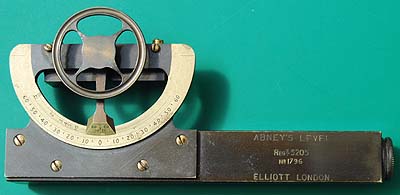
Elliott Bros, London Abney level no 1796, registered no 5205, It has a Morocco covered card case. The design, by Capt. Abney, was registered in 1884 and this level is an early example , probably dating from the end of the 19th century. Behind the top bar is a level tube which is rotated by the milled hand wheel. In use the object of which the height is to be determined is sighted through the instrument and the bubble tube is rotated until the bubble, viewed in a mirror in the sighting tube, is brought to the same position as the top of the sighted object.

This 19th century Abney level is unsigned. It has a magnifier and the angle scales are divided to + 90 degrees whilst the Elliott one is only divided to + 60 degrees.. Unlike my other Abneys the mirror is in its early position across the top half of the tube rather than at one side. The morocco covered, silk & velvet lined case is unusual for an instrument intended to be used in the field.


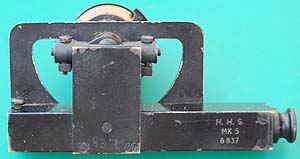
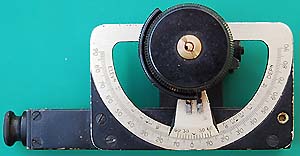
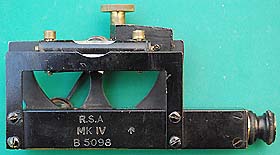
RSA Mk IV Abney level B5098. A service pattern Abney level made for the British military by R S Aldridge, London. The vernier is divided to 10 minutes and it is adjusted by the thumb wheel at the top. It has a two draw eyepiece, which extends the instrument to 7 inches overall length The mirror is silver. It has degree and gradient scales.
Mk 5 Abney level by H H S, B837 dating from 1944. It has a leather case stamped with the broad arrow and PIC 1944 Mk V 33. It has an extending sighting tube. The outer knurled sector is used for coarse adjustment and the inner knurled wheel for fine adjustment. It is missing its magnifier for reading the vernier. The scales are similar to those of the Mk IV above.

A G Thornton 5 inch Abney level with compass, probably dating from the early 20th century.

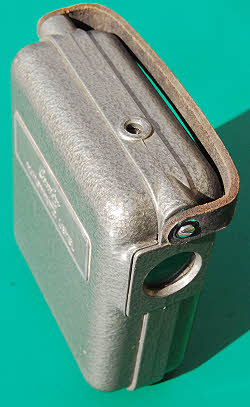
Cowley automatic level, serial no 26377, probably made by Hilger & Watts ca.1960. It has a black leather sling case & instructions.
It would originally have been supplied with a special tripod, staff, and special target. Its main use would have been for laying out ground works on building sites.
It would originally have been supplied with a special tripod, staff, and special target. Its main use would have been for laying out ground works on building sites.
The special tripod has a vertical spike on top that is inserted through a hole in the base if the instrument. It both holds the unit in place and
releases the mirrors that are the main feature of the instruments mechanism. Looking down through the hole in the top the staff and target are located centrally in the field of view. The target will appear with one half displaced vertically from the other in the mirrors. The assistant then moves the target up or down the staff until the two images of the target coincide at which point the height can be read off the staff. By rotating it around the tripod without moving the tripod several measurements at different staff positions can be made.

A G Thornton pocket level, ca.1900. It has a black card case. In use the reflection of the bubble in a mirror has to be aligned with cross hairs.
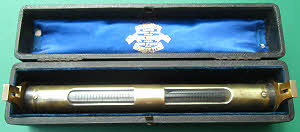

A G Thornton large size (9” LOA) suspension level. It was normally used in conjunction with a special cord that Thornton sold in a range of lengths and had a variety of uses in building , establishing levels and engineering. It could also be used as a precision level resting on its feet
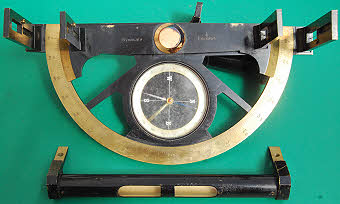
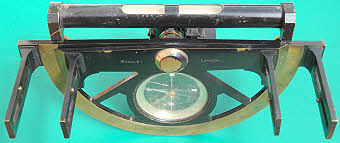
A W F Stanley eight-inch semicircumferentor made of brass and black-lacquered brass. It is also equipped with a level tube that can be screwed under the base beam as shown in the second picture. With this fitted and the arc held in the vertical plane rather than horizontal it can be used as a clinometer. The semi-circle is graduated to half a degree and the vernier reads to one minute of arc. For land surveying it is a simple alternative to a theodolite, though less accurate, for small scale surveys. The shorter alidade can be rotated relative to the larger, fixed alidade for measuring angles between objects and the baseline.
| Early Sets |
| Traditional Sets |
| Later Sets |
| Major Makers |
| Instruments |
| Miscellanea |
| W F Stanley |
| A G Thornton |
| W H Harling |
| Elliott Bros |
| J Halden |
| Riefler |
| E O Richter |
| Kern, Aarau |
| Keuffel & Esser |
| Compasses |
| Pocket compasses |
| Beam compasses |
| Dividers |
| Proportional dividers |
| Pens |
| Pencils |
| Rules |
| Protractors |
| Squares |
| Parallels |
| Pantographs |
| Sectors |
| Planimeters |
| Map Measurers |
| Miscellaneous |
| Materials Used |
| Who made them |
| Who made these |
| Addiator |
| Addimult |
| Other German |
| USA |
| Miscellaneous |
| Microscopes |
| Barometers |
| Hydrometers & Scales |
| Pedometers |
| Surveying Instruments |
| Other instruments |
| Workshop Measuring Tools |
| Catalogues & Brochures |
| Levels & Theodolites |
| Compasses & Clinometers |
| Miscellaneous surveying |
| Micrometers & Verniers |
| Engineering rules and gauges |
| Wood rules & calipers |
| Dial gauges & miscellaneous |